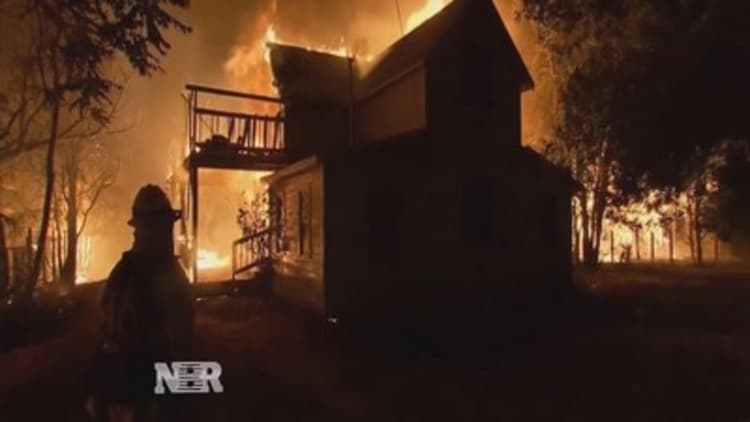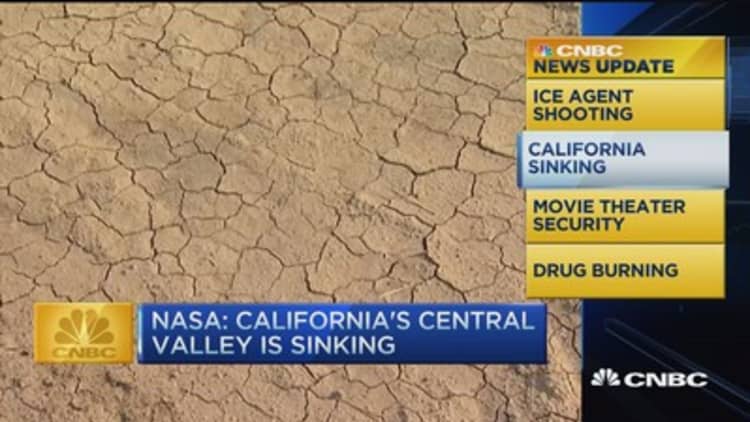California's drought will not be permanent. But the state needs to make changes to prepare for the next one.
So says Jay Lund, director of the Watershed Sciences Center at the University of California, Davis. Policymakers, businesses and others will have to prepare for the likelihood that droughts as severe as the current one are more likely to happen at least twice in people's lifetime, Lund told CNBC.
The distinction between a "new normal" and periods of drought is important, because it will guide policy decisions and investments in technology to improve resilience.
"It will undoubtedly get wet again within a few years," agreed Park Williams, a climate scientist at Columbia University who recently published a study concluding that a warming climate is intensifying drought conditions. "Anybody who tells the public that this drought is 'the new normal' without qualifying that statement is unwisely suggesting that California is going to forever remain as dry as it is now. People who believe this are primed to feel resentment when the rains return, potentially causing them to stop supporting some much-needed policy changes that are needed to enhance California's resilience to drought."
California is "managing pretty well" in this drought, Lund said, but it has laid bare a few areas where the state has been unprepared. For example, the state has a tiered water rights system for property owners that dates back more than 150 years.

Some water rights holders face few restrictions on water that flows past their property. Last year, the California State Water Resources Control Board began to move toward curtailing water rights, even for longstanding rights holders who have had the most secure access. It was the first time the government took such action in almost half a century.
Particularly vulnerable now are the state's groundwater supplies, which many users, especially farmers, have drawn on heavily in order to keep orchards, crops or livestock alive.
Historically, California has had no way of keeping track of how much groundwater people are pumping out of the ground. The state passed its first statewide groundwater monitoring laws only last year, and some landowners have resisted the government's attempts to monitor something they consider their property.
If you look at the history of water management in California, it is a history of droughts and floods and lawsuits.Jay LundUniversity of California, Davis
Dried-up groundwater has even caused the earth to sink in some areas, collapsing the caverns where water collects—which in turn further threatens future groundwater supplies.
"If managed properly, groundwater can and should be used as a backstop during times of drought," Williams wrote in an email to CNBC. But he added that "this only works in the long run if groundwater is managed sustainably, meaning not extracting too quickly, and then replenishing during wet years. This is generally not the current practice."
Where the state puts money also matters. Desalination plants have been touted by some as an answer to recurring drought. A company called Poseidon Water is building a nearly $1 billion desalination plant in Carlsbad, California—so far the largest project in the United States—and is building another plant in Huntington Beach.
Lund of UC-Davis warned, however, that desalination is not a panacea, calling it "great way to spend a lot of money." Desalination may be a viable technology in areas where water is chronically short, such as Saudi Arabia, or it might be just one tool to have in the toolkit.

Some of the big investments in desalination outside of desert countries aren't necessarily paying off.
Australia, for example, made significant investments in desalination plants during a decade long drought, sparking criticism for the technology's high costs and environmental effects. Now, they seem redundant since heavy rains have been falling in the country.
Likewise a desalination plant built during a drought in the 1980s in Santa Barbara, California, ran for only a few weeks before it was shut down once rain returned. The current drought has led local officials to consider reopening the plant, which could cost up to $40 million—that is on top of the $35 million spent on building it.
Other methods, such as water conservation, water recycling and storm-water capture, are more cost effective in regions where water is likely to fall again, Lund said.
"Droughts are a very good test, that remind us that we need to make these changes," Lund said. "If you look at the history of water management in California, it is a history of droughts and floods and lawsuits."


